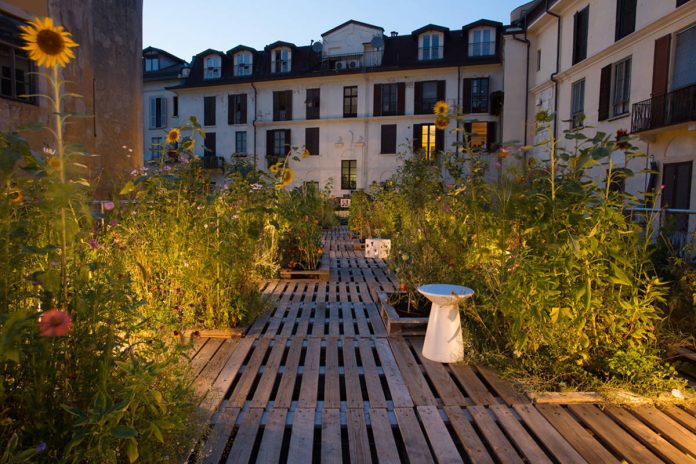The Piuarch architectural firm has designed a model reproducible garden, inspired by the international urban farming movement. At their studio in Via Palermo, the architects have created a roof reconversion project, with minimum resource investment and maximum benefits. These include a reduction in the cost of cooling in summer, a decrease in waste water flow due to rainwater absorption, a reduction in temperature from 2 to 5 degrees inside and an improvement in the quality of the work environment in terms of the climate and energy, as well as from an economic and social point of view.
The modular pallet system allows for the creation of structures that are easy to assemble, where there are paths for walking high up, small planted areas for growing fruit, vegetables and aromatic plant species, places for relaxing and sunbathing while admiring the view from above, and places for welcoming guests and for brief lessons or work meetings. The project was developed with landscape designer Cornelius Gavril and with the collaboration of VerdeVivo. It is also designed to educate children, who can touch with their hands and observe how fruit and vegetables grow.
The Via Palermo vegetable garden is certainly not the only one of its kind in the center of Milan. On the seventh floor, next to the spiers of the Duomo, is the Hotel Milano Scala’s garden in Via dell’Orso 7. Here, aromatic herbs, flowers, seasonal fruit and vegetables are grown, which are directly used in the hotel kitchen.
From Milan to Turin, hotel gardens are a growing trend. In the historic 17th-century palazzo, the rooftop terrace at the NH Collection Piazza Carlina in Turin, contains a garden, where ingredients for the Carlina restaurant on the ground floor are grown.
Not only the hotels, but also the districts of Turin will turn green thanks to the OrtiAlti project, set up by architects Elena Carmagnani and Emanuela Saporito, who share the same passion for sustainable architecture and urban regeneration. For their gardens, they use a variety of textile and plastic materials that are laid on flat roofs, making them waterproof but allowing the water to be retained and to easily flow. Above this layer, it only takes 10-15 cm of a special, lightweight, easy-to-use soil to start growing plants at a high altitude.







